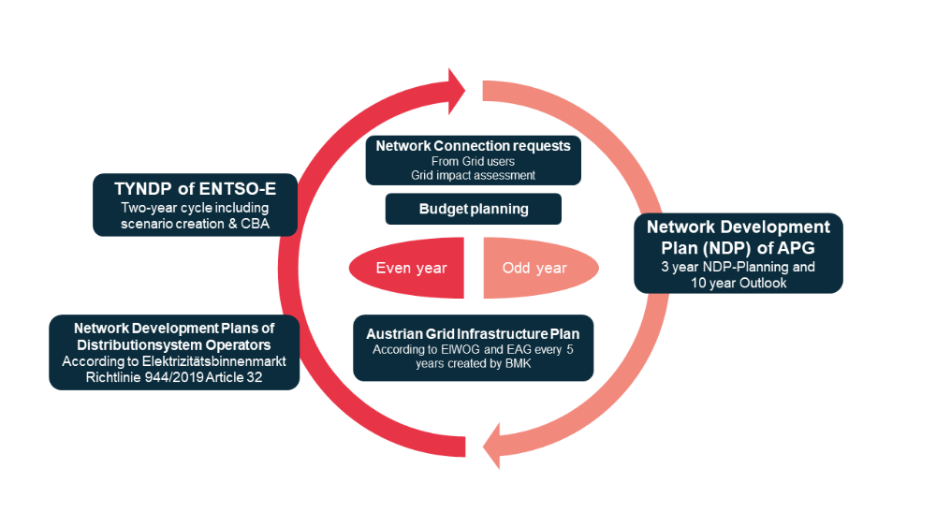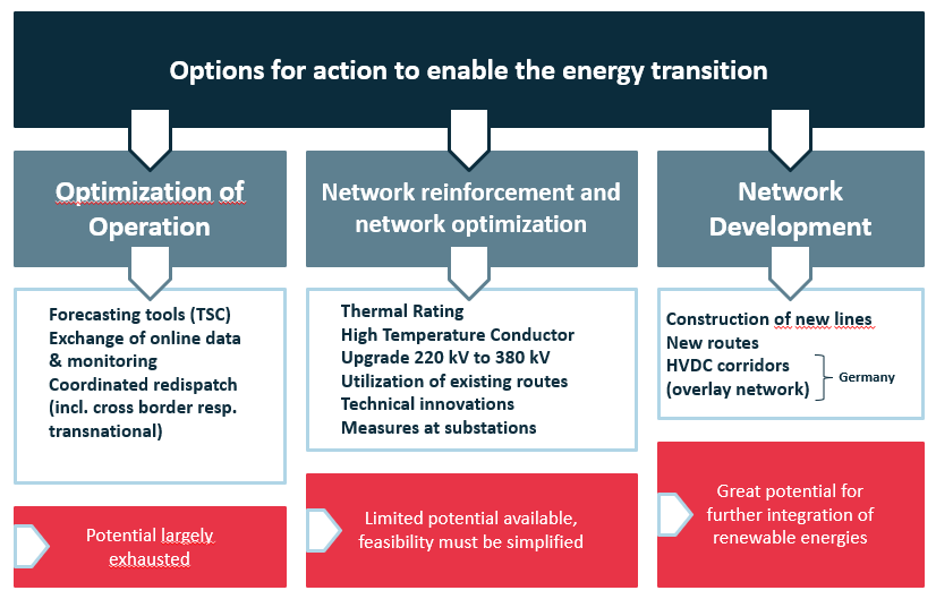Grid expansion
Legal obligations as a transmission system operator
APG as a transmission system operator is required to fulfil extensive legal obligations in the planning and operation of its high-voltage power lines. In providing a public service, APG has a duty not only to ensure non-discriminatory treatment of all its customers, but also to build and maintain an adequate grid infrastructure (Section 5(1) of the 2010 Austrian Electricity Industry and Organisation Act (Elektrizitätswirtschafts- und -organisationsgesetz, ElWOG)). In its role as the transmission system operator and control area manager, APG has an obligation to operate as well as to expand and maintain the transmission grid safely, reliably and efficiently, taking into account environmental considerations (Section 40(1)(1) ElWOG 2010). Specifically, the Act (Section 40(1)(7) ElWOG 2010) makes reference to the requirement to ensure that the grid is able to meet reasonable demands for transmission of electricity in the long term.
Section 37 ElWOG 2010 – amended by the Renewable Energy Development legislative package
(EAG package) of 27 July 2021 (Federal Law Gazette (BGBl) I No. 150/2021) – requires the transmission system operator to prepare a Network Development Plan every two years and submit this to the regulatory authority for approval. This shall be based in particular on the data generated from grid operation management, forecasts of generation and consumption as well as energy market trends and scenarios (at both a national and a European level).
In the interest of efficient and forward-looking grid expansion planning, the Austrian transmission system operators APG and VÜN (Vorarlberger Übertragungsnetz) create long-term scenarios for the requirements of the Austrian transmission grid and the expected grid situations. Planning is carried out at the European level with the “Regional Investment Plans” and the Ten-Year Network Development Plan (TYNDP) of ENTSO-E (European Network of Transmission System Operators), which are published every two years. Since 2011, the grid development plans (NDP) of APG and VÜN have been created with a 10-year outlook. They are being prepared and submitted for approval every odd year. Additionally, since 2023, the integrated Austrian Grid Infrastructure Plan ((Ö)NIP) has been created on a five-year cycle by the Federal Ministry for Climate Action, Environment, Energy, Mobility, Innovation, and Technology (BMK). The ÖNIP is a comprehensive strategic instrument that outlines the fundamental requirements and directions of grid planning in the electricity and gas sectors for a holistic energy transition. The adjacent figure provides an overview of the different planning instruments.
Network optimisation before "NOVA" expansion
APG’s grid expansion planning builds on sustainable ideas in an effort to make use of the transmission capacity more efficient, reduce the environmental impact and minimise the societal cost. For this, APG applies the NOVA principle (an acronym of the German phrase Netz-Optimierung vor Ausbau, or grid optimisation before expansion)1. The courses of action available include optimisation of operational management, rehabilitation/modernisation, grid reinforcement and optimisation of existing systems and routes and – in the third step – measures for grid expansion on new routes. The next stage in the grid development process will only be considered after the possibilities in the preceding step have been exhausted. Building new lines on a new route is usually the last option chosen – for cost reasons, among other things.
The NOVA principle is applied in both overall grid development and individual grid expansion projects. Individual variants are considered for each project, taking into account the design criteria as well as the age and condition of existing lines and systems. The (extensive) maintenance and rehabilitation that is often needed for older lines is also factored in. In the third stage, new routes for building new lines are selected based on the following criteria:
- cost-effectiveness: optimisation of grid concepts and, if possible, joint routes/co-routing with or of 110-kV lines operated by the distribution system operators;
- environmental protection: avoidance of proximity to sensitive land use, sensitive landscapes and nature reserves, as well as combining routes with other linear infrastructures if possible; and
- safety: maintaining standards for operational and systems safety.
In addition, the following routing principles are taken into account as efficiently as possible:
- consideration of constraint points such as existing and planned transformer stations and connection points to the APG grid;
- minimal impact on residential areas and the natural environment;
- avoidance of residential areas, taking into account human medical criteria such as climate and air, noise and electromagnetic fields (EMF);
- essential avoidance of use/crossing of areas where routes cannot be built, such as areas protected under nature conservation laws (in particular European nature reserves, nature conservation areas or other protected areas and protected parts of the landscape as well as highly sensitive landscapes or high-quality recreational areas); and
- parallel routing with existing overhead lines (joint routes) or other linear infrastructures (e.g. roads, railway lines, etc.).
With a view to sustainable and ecological route management, APG also implements numerous projects for the protection of native fauna and flora along the routes in collaboration with environmental organisations and universities.
The acronym “NOVA” is adopted from the German Transmission System Operator and the German Grid Development Plan.



